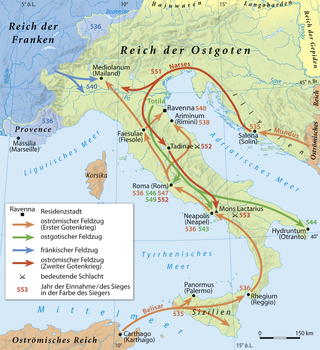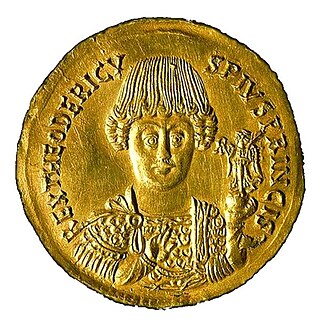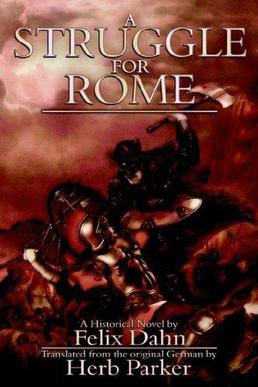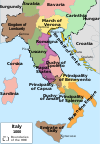
The Ostrogoths were a Roman-era Germanic people. In the 5th century, they followed the Visigoths in creating one of the two great Gothic kingdoms within the Western Roman Empire, drawing upon the large Gothic populations who had settled in the Balkans in the 4th century. While the Visigoths had formed under the leadership of Alaric I, the new Ostrogothic political entity which came to rule Italy was formed in the Balkans under Theodoric the Great.
The 550s decade ran from January 1, 550, to December 31, 559.

Year 552 (DLII) was a leap year starting on Monday of the Julian calendar. The denomination 552 for this year has been used since the early medieval period, when the Anno Domini calendar era became the prevalent method in Europe for naming years.

Narses was, with Belisarius, one of the great generals in the service of the Byzantine Emperor Justinian I during the Roman reconquest that took place during Justinian's reign. Narses was a Romanized Armenian. He spent most of his life as an important eunuch in the palace of the emperors in Constantinople.

Totila, original name Baduila, was the penultimate King of the Ostrogoths, reigning from 541 to 552 AD. A skilled military and political leader, Totila reversed the tide of the Gothic War, recovering by 543 almost all the territories in Italy that the Eastern Roman Empire had captured from his Kingdom in 540.
Ildibad was a king of the Ostrogothic Kingdom in AD 540–541.

At the Battle of Taginae in June/July 552, the forces of the Byzantine Empire under Narses broke the power of the Ostrogoths in Italy, and paved the way for the temporary Byzantine reconquest of the Italian Peninsula.

The Battle of Mons Lactarius took place in 552 or 553 AD during the Gothic War waged on behalf of Justinian I against the Ostrogoths in Italy.

The Gothic War between the Byzantine Empire during the reign of Emperor Justinian I and the Ostrogothic Kingdom of Italy took place from 535 to 554 in the Italian Peninsula, Dalmatia, Sardinia, Sicily and Corsica. It was one of the last of the many Gothic Wars against the Roman Empire. The war had its roots in the ambition of the Byzantine emperor Justinian I to recover the provinces of the former Western Roman Empire, which the Romans had lost to invading barbarian tribes in the previous century, during the Migration Period.

The Ostrogothic Kingdom, officially the Kingdom of Italy, existed under the control of the Germanic Ostrogoths in Italy and neighbouring areas from 493 to 553.
Widin was the last attested Ostrogothic noble in Italy. After Teia's defeat at the hands of the Byzantine eunuch general Narses at the Battle of Mons Lactarius, south of present-day Naples, in October 552 or early 553, organized Ostrogothic resistance ended. Widin, however, was able to organize a Gothic revolt in northern Italy in 561. According to Paul the Deacon, Widin comes Gothorum and Amingus, a Frank, rebelled against Narses.

A Struggle for Rome is a historical novel written by Felix Dahn.

The Battle of Sena Gallica, was a naval battle fought off the Italian Adriatic coast in the autumn of 551 between an East Roman (Byzantine) and an Ostrogoth fleet, during the Gothic War (535–554). It marked the end of the Goths' brief bid to deny the seas to the Romans, and the beginning of the Byzantine resurgence in the war under the leadership of Narses.
Aligern or Aligernus was an Ostrogoth military leader, active in the Gothic War (535-554). By the end of the war, Aligern had joined the Byzantine army. The main sources about him are Procopius and Agathias.
John, the nephew of the rebel Vitalian, was an Eastern Roman general under Justinian I, who was active in the Gothic War in Italy and against the Gepids in the western Balkans. He was married to Justina, the daughter of Justinian's cousin Germanus.
Indulf, also known as Gundulf, was a Byzantine mercenary who defected to the Ostrogoths and became a leader in their army in the last years of the Gothic War of 535–554.
Ragnaris was a Hunnic warlord who fought for the Ostrogoths in the final stages of the Gothic War against the Eastern Roman Empire. Procopius calls him a Goth, but the better informed Agathias records that he was of the Hunnic tribe of the Vittores or Vitgores.
Coccas was an Eastern Roman soldier who deserted to the Ostrogoths during the final stages of the Gothic War. Procopius calls him "a Roman soldier" and "a man of the Gothic army". His name is not Germanic, and might be Thracian.
Scipuar was a commander of the Ostrogoths in the final stages of the Gothic War against the Eastern Roman Empire.
Dagisthaeus was a 6th-century Eastern Roman military commander, probably of Gothic origin, in the service of the emperor Justinian I.
![Quarter siliqua of Teia. Obverse text in Late Latin: D[OMINUS] N[OSTER] THEIA RIX [sic] ("Our lord Teia the King"). Quarter Siliqua of Theia, 552 AD.jpg](http://upload.wikimedia.org/wikipedia/commons/thumb/b/b1/Quarter_Siliqua_of_Theia%2C_552_AD.jpg/220px-Quarter_Siliqua_of_Theia%2C_552_AD.jpg)









